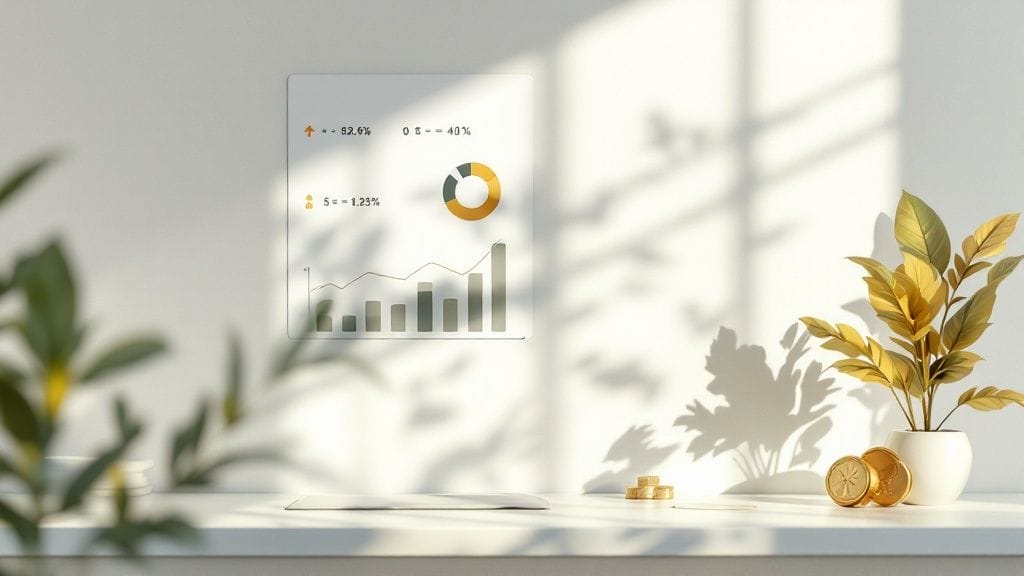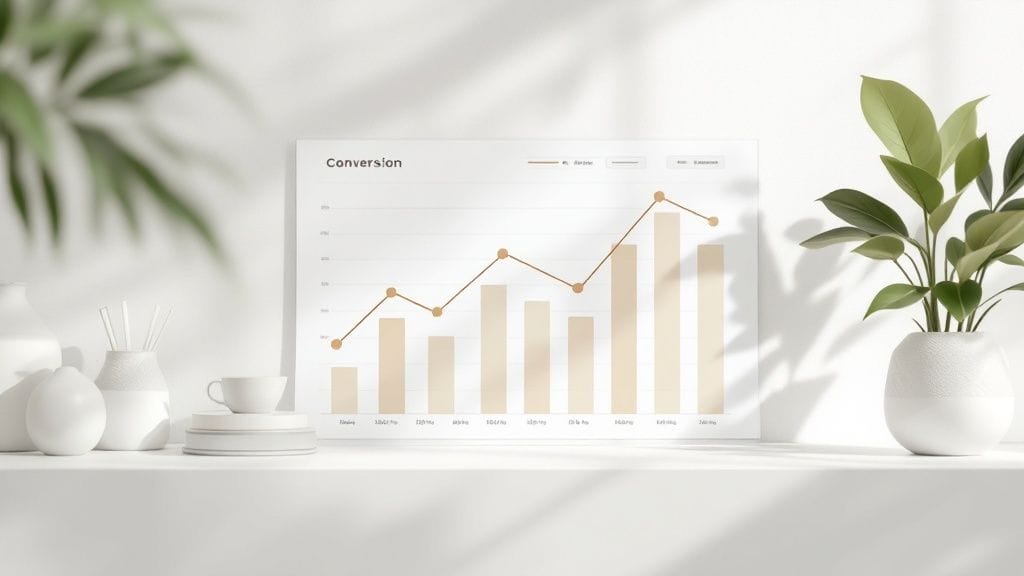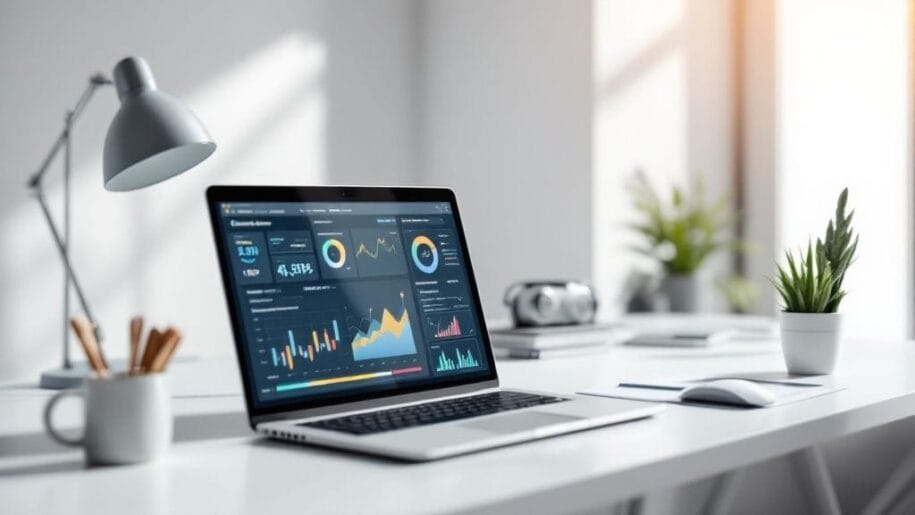The Real Power Behind Conversion Rates

Conversion rates are more than just metrics; they are vital signs of your online business. They reflect how well your marketing performs and the quality of your website’s user experience. This essential metric offers valuable insights into the customer journey, highlighting what’s effective and what needs refining. Knowing how to calculate your conversion rate enables you to make informed choices that directly affect your profits.
Why Conversion Rates Matter
Different conversions, like sales, lead generation, email sign-ups, and free trial activations, tell a story about customer behavior. A high free trial conversion rate, for example, might indicate an attractive offer. However, a low conversion rate from free trials to paying customers could signal issues with the onboarding process.
Tracking different conversion points is key to a complete understanding of your customer journey. Analyzing these metrics helps you identify areas for growth and optimize your marketing budget for the best return on investment. This data-driven approach sets successful businesses apart.
Calculating conversion rates is essential for gauging marketing effectiveness and website design. A standard conversion rate formula is: Conversion Rate = (Number of Conversions / Total Number of Visitors) * 100. If an online store has 1,000 visitors and 20 sales, the conversion rate is 2%.
Conversion rates are industry-specific; typically, 2% to 5% is considered good. Understanding these rates helps businesses identify areas for improvement, like website navigation and product offerings, to boost sales efficiency. Analyzing conversion rates also allows companies to refine their marketing to target potential customers more effectively. Find more detailed statistics here: Learn more about conversion rates.
Optimizing Your Landing Pages for Conversions
Landing pages are critical for your overall conversion rate. They’re often the first interaction a potential customer has with your business. A well-optimized landing page can significantly influence whether a visitor converts or leaves. This is where thoughtful design and compelling copy come in.
To further improve conversion rates, consider how to optimize your SaaS landing page for conversions. Focusing on clear calls to action, engaging content, and a seamless user experience can turn your landing pages into effective conversion tools. Even minor landing page improvements can significantly increase revenue.
How to Calculate Conversion Rate: A Practical Framework

Calculating your conversion rate is key to understanding how well your marketing efforts are working. This section gives you a practical way to measure it accurately, no matter your business type. We’ll look at the main formula and how it works in different situations.
Understanding the Core Formula
The basic formula is simple:
Conversion Rate = (Number of Conversions / Total Number of Visitors) * 100
So, if you had 50 conversions from 1,000 visitors, your conversion rate is 5%. Easy enough, right? But using this formula correctly means you need to understand what “conversions” and “visitors” actually are.
Defining Conversions and Visitors
A conversion is a specific action you want visitors to take on your website. This could be a purchase, signing up for emails, downloading something, or even requesting a product demo. Clearly defining your conversion goals is essential. An online store, for example, might focus on sales, while a blog might want more email subscribers.
Visitors are the total number of people who visit your website. This includes both new and returning users. Keeping track of your visitor count is important. Tools like Google Analytics give you reliable data.
Applying the Formula: Real-World Examples
How you use the conversion rate formula depends on your business. Here are some examples:
E-commerce: Conversions usually mean sales. 200 sales from 5,000 visitors means a 4% conversion rate.
B2B (Business-to-Business): Conversions often mean leads, like form submissions or demo requests. 50 demo requests from 1,000 visitors gives a 5% conversion rate.
Content-Focused Websites: Conversions might be email sign-ups or downloads. 100 new subscribers from 2,000 visitors results in a 5% conversion rate.
To further illustrate these calculations, let’s take a look at a table showcasing some real-world examples.
Conversion Rate Calculation Examples
The table below provides further clarity on calculating conversion rates across various business types:
| Business Type | Visitors | Conversions | Calculation | Conversion Rate |
|---|---|---|---|---|
| E-commerce | 10,000 | 250 | (250/10,000) * 100 | 2.5% |
| B2B | 2,000 | 100 | (100/2,000) * 100 | 5% |
| Content-Focused | 5,000 | 200 | (200/5,000) * 100 | 4% |
As you can see, the conversion rate varies depending on the context of the business and its goals.
Choosing the Right Analytics Platform
Several tools can help you track your conversion rate. Google Analytics is a popular option, offering lots of data on website traffic and conversions. Other platforms like Mixpanel and Kissmetrics offer more specialized features for user behavior and segmentation.
The best platform for you depends on your needs and business model. A subscription-based business, for instance, might need a platform that tracks recurring revenue. Tracking this data carefully helps you get meaningful insights, not just surface-level numbers. Focusing on the right data and understanding how to calculate conversion rates helps you optimize your marketing for real business growth.
Benchmarking Success: Industry Standards Revealed

Understanding your conversion rate is essential for any business. But what makes a “good” rate? It varies significantly across industries. For example, a high-value B2B service will likely have a lower conversion rate than an online store selling less expensive products. B2B sales cycles tend to be longer and involve higher price points, naturally leading to fewer, but often more profitable, conversions. Knowing your industry benchmarks is key.
Decoding Industry Benchmarks
Conversion rate expectations shift dramatically across sectors. E-commerce stores, often driven by impulse buys, may see conversion rates between 1% and 3%.
SaaS businesses, with their subscription models and longer sales cycles, might consider 5% to 7% conversion on free trials a win. Understanding customer behavior is paramount to setting the right goals.
Lead generation businesses prioritize capturing qualified leads over immediate sales. Conversion rates of 10% or higher are common in this space.
Service businesses, often relying on consultations, may define conversions as appointment bookings or contact form submissions. A 3% to 5% conversion rate could indicate a healthy pipeline. A financial advisor, for example, might consider a 4% conversion rate on consultation requests a positive outcome.
Understanding Sales Conversion Rates
Beyond industry averages, other factors come into play. The sales conversion rate, particularly crucial for SaaS companies, measures the effectiveness of sales and marketing efforts. It’s calculated by dividing closed deals by total opportunities, then multiplying by 100.
For example, if a company has 100 opportunities and closes 20, their sales conversion rate is 20%. You can learn more about this at Mosaic. This metric is crucial for identifying roadblocks and optimizing strategies.
To illustrate the typical conversion rate variations between industries, let’s take a look at the following table:
Average Conversion Rates By Industry
Benchmark data showing typical conversion rates across major industries
| Industry | Average Conversion Rate | Top Performer Rate | Notes |
|---|---|---|---|
| E-commerce | 1-3% | 5-7% | Often driven by impulse purchases |
| SaaS | 5-7% | 10-15% | Focus on free trials and subscriptions |
| Lead Generation | 10%+ | 20%+ | Prioritizes capturing qualified leads |
| Service Businesses | 3-5% | 7-10% | Measures conversions through bookings or contact forms |
This table highlights the significant differences in conversion rates. While e-commerce relies on high volume, lower-priced sales, SaaS and lead generation prioritize higher value conversions, albeit at lower volumes. Service businesses, with their personalized interactions, fall somewhere in between.
Setting Realistic Targets
Don’t chase arbitrary numbers. Focus on attainable targets reflecting your specific business. Consider your average purchase value, sales cycle length, and customer behavior. Higher purchase values often mean lower conversion rates as customers take more time to decide.
Longer sales cycles also mean fewer conversions in a given timeframe. By analyzing these factors, you can establish SMART (Specific, Measurable, Achievable, Relevant, and Time-bound) goals.
Focusing on Continuous Improvement
Benchmarking is an ongoing process. Regularly track your conversion rate, compare it against industry averages and your historical performance, and identify opportunities for improvement. By continually analyzing and refining your strategies, you can steadily increase your conversion rate over time. This iterative process helps your marketing efforts stay effective and your business stay competitive.
Advanced Conversion Analysis That Drives Results

Calculating your overall conversion rate is a good first step. But to really boost your marketing performance, you need a more detailed approach. This means going beyond the basics and understanding how different customer groups interact with your website. This deeper dive reveals hidden potential and helps address areas that aren’t performing well.
Segmentation: Uncovering Hidden Opportunities
Segmentation lets you examine conversion patterns across various factors. These factors can include where your traffic comes from, the devices people use, their demographics, and even their specific behaviors on your site.
This detailed view can highlight areas for improvement that a basic conversion rate might overlook. For example, you might discover that mobile users have a lower conversion rate compared to desktop users. This could indicate a need to optimize your website for mobile devices.
Traffic Sources: Analyzing conversions by traffic source (like organic search, social media, or paid advertising from platforms like Google Ads) shows you which channels are bringing in the most valuable customers.
Devices: Comparing conversion rates across desktops, mobile phones, and tablets can reveal usability problems specific to certain platforms.
Demographics: Understanding how different demographic groups convert allows you to tailor your marketing messages and offers for better results.
User Behavior: Analyzing conversion rates based on what users do on your site (such as the pages they visit or how long they stay) can uncover ways to optimize the entire customer journey.
This targeted method reveals which segments are performing well and which need more attention, leading to a stronger overall strategy.
Micro-Conversions: Optimizing The Customer Journey
Top companies use micro-conversions to track smaller actions within the customer journey. These actions, while not the ultimate conversion goal, still contribute to it. Think of it as a roadmap: the final destination is a purchase, but the smaller steps along the way – like adding an item to a shopping cart or signing up for an email newsletter – are micro-conversions.
By monitoring these smaller steps, you can identify friction points in the user experience. This pinpoints areas in the sales funnel where customers are abandoning the process. Addressing these issues improves the overall flow and makes it more likely that customers will reach the main conversion goal. This could mean simplifying the checkout process or making your call to action more prominent.
Cohort Analysis: Measuring Long-Term Impact
Cohort analysis groups users based on shared characteristics, such as their sign-up date or first purchase. This method reveals trends that might be hidden in standard reports by tracking the behavior of these user groups over time. For example, analyzing the buying habits of users who signed up in January versus February might reveal important seasonal trends.
This approach goes beyond a single snapshot of your conversion rate. It lets you measure the long-term effectiveness of your marketing campaigns and product changes. This long-term perspective informs smarter business decisions, giving you a real competitive advantage. Cohort analysis is especially useful for subscription-based businesses, allowing them to effectively track customer lifetime value and churn rates. This detailed analysis helps businesses adapt and refine their strategies for sustainable growth.
The Evolution of Conversion Optimization
Understanding the history of conversion optimization gives us valuable context for the future. From simple website visitor counters to the complex analytics platforms we use today, the field has undergone a remarkable transformation. This journey highlights how changes in technology and consumer behavior have driven the evolution of what’s possible.
From Basic Counts to Data-Driven Decisions
Historically, conversion rates have been a constantly shifting landscape, adapting to advancements in technology and evolving consumer preferences. In the early days of e-commerce, conversion rates were generally low. Websites lacked functionality, and online shopping felt risky. For a deeper dive into these trends, check out this resource on historical conversion rate trends. As websites became more user-friendly and digital marketing strategies matured, conversion rates saw a corresponding increase. The rise of mobile shopping and more streamlined payment options played a significant role in this upward trend.
The Rise of Mobile and the Impact of User Experience
The proliferation of mobile devices has fundamentally changed conversion optimization. Optimizing websites for smaller screens and diverse user interactions became essential. With the surge in mobile usage, the focus shifted to creating a positive mobile user experience. This gave rise to mobile-first design and a renewed emphasis on page load speeds, both directly impacting conversion rates.
Personalization and the Power of AI
How businesses calculate conversion rates has also evolved. While the fundamental formula remains – (Conversions / Visitors) * 100 – the tools and methods we use to track and analyze these figures are constantly changing. The process now involves not only assessing overall rates but also understanding individual user behavior.
For instance, machine learning is being utilized to personalize user experiences. By processing large datasets, these systems can anticipate what a user might be interested in seeing, ultimately improving conversion rates. This ability to tailor content and offers enhances engagement and increases the probability of conversion.
The Future of Conversion Optimization
Looking ahead, AI-powered insights will become even more critical. Predictive analytics will empower companies to create experiences that surpass basic personalization. This will involve developing dynamic content that adapts in real-time to a user’s actions. As the digital world continues to evolve, businesses that prioritize conversion rate optimization and incorporate advanced analytics are poised to achieve greater success and profitability. Integrating these innovations will enable businesses to anticipate customer needs and craft more targeted and efficient campaigns. This proactive approach represents the future of conversion optimization.
Proven Strategies to Transform Your Conversion Rates
Now that you understand how to calculate and interpret your conversion rate, let’s explore practical ways to improve it. This section offers actionable strategies to boost your conversions, providing guidance you can implement immediately.
Understanding the Conversion Funnel
Before diving into tactics, it’s essential to grasp the conversion funnel concept. This represents the customer journey from initial contact to final purchase. Imagine a real-world funnel: many potential customers enter at the top, but fewer reach the bottom, converting into paying customers. Each stage represents a small step, a micro-conversion, toward the ultimate goal.
Awareness: A potential customer discovers your website or advertisement.
Interest: The visitor interacts with your content, demonstrating interest in your offerings.
Desire: The visitor develops a preference for your product or service, often comparing it with alternatives.
Action: The visitor completes the desired action, like purchasing a product or starting a free trial.
Analyzing each funnel stage reveals where you’re losing potential customers, highlighting areas for improvement.
Optimizing Your Website for Conversions
Your website is a critical part of your conversion strategy. Implementing these proven techniques can significantly impact your results:
A/B Testing: This involves creating two web page versions with a single difference (like button color or headline text) and testing which performs better. Small changes can yield significant improvements.
User Experience (UX) Enhancements: A positive user experience is essential. This includes easy navigation, visual appeal, and mobile-friendliness. A smooth, intuitive experience encourages longer visits and further exploration.
Persuasive Copywriting: Use language that resonates with your target audience, emphasizing your products’ or services’ benefits. Focus on the value you provide and how you solve their problems.
Building Trust and Credibility: Displaying testimonials, security badges, and guarantees builds customer trust, especially crucial for e-commerce businesses where security is paramount.
These tactics, used effectively, create a website that not only attracts visitors but also converts them.
Targeted Strategies Based on Industry
Different industries require different optimization approaches. Here are a few examples:
E-commerce: Prioritize clear product descriptions, high-quality images, and simple checkout processes. Streamlining the purchase path is crucial.
SaaS (Software as a Service): Offer free trials or demos, allowing potential customers to experience your software’s value. Highlight key benefits and how they address specific business challenges.
Lead Generation: Create attractive lead magnets, like ebooks or webinars, in exchange for contact information. Offer valuable content to nurture leads and guide them towards becoming paying customers.
Aligning your strategies with your industry targets your efforts more effectively.
Utilizing Social Proof
Social proof significantly influences consumer behavior. This involves using testimonials, reviews, case studies, and social media engagement to demonstrate positive experiences. Highlighting positive reviews and user-generated content builds trust and encourages others to follow.
By incorporating these strategies, you create a cohesive conversion optimization approach. Addressing each area creates a more engaging and persuasive customer journey, ultimately boosting conversion rates. Analyzing your conversion rate and continually improving turns visitors into loyal customers, driving business growth.
Ready to improve your social proof strategy? Explore Notifyio.net‘s resources and learn how to leverage social proof to enhance your brand, build trust, and drive more conversions.




Leave a Reply